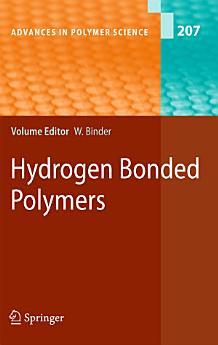Hydrogen Bonded Polymers
Wolfgang Binder
Feb 2007 · Advances in Polymer Science Book 207 · Springer
Ebook
206
Pages
reportRatings and reviews aren’t verified Learn More
About this ebook
Control of polymeric structure is among the most important endeavours of modern macromolecular science. In particular, tailoring the positioning and strength of intermolecular forces within macromolecules by synthetic me- odsandthusgaining structuralcontrolover the?nalpolymeric materials has become feasible, resulting in the?eld of supramolecular polymer science. - sides other intermolecular forces, hydrogen bonds are unique intermolecular forces enabling the tuning of material properties via self-assembly processes -1 overawiderangeofinteractionstrengthrangingfromseveralkJmol tosev- -1 eraltensofkJmol . Centralfortheformationofthesestructuresareprecursor molecules of small molecular weight (usually lower than 10 000), which can assembleinsolidorsolutiontoaggregatesofde?nedgeometry. Intermolecular hydrogenbondsatde?nedpositionsofthesebuildingblocksaswellastheir- spectivestartinggeometryandtheinitialsizedeterminethemodeofassembly into supramolecular polymers forming network-, rodlike-,?brous-, disclike-, helical-, lamellar- and chainlike architectures. In all cases, weak to strong hydrogen-bondinginteractionscanactasthecentralstructure-directingforce fortheorganizationofpolymerchainsandthusthe?nalmaterials'properties. Theimportantcontributionofhydrogenbondstotheareaofsupramole- lar polymer chemistry is de?nitely outstanding, most of all since the potency of hydrogen-bonding systems has been found to be unique in relation to other supramolecular interactions. Thus the high level of structural diversity of many hydrogen-bonding systems as well as their high level of direction- ity and speci?city in recognition-phenomena is unbeaten in supramolecular chemistry. The realization, that their stability can be tuned over a wide range of binding strength is important for tuning the resulting material prop- ties, ranging from elastomeric to thermoplastic and even highly crosslinked duroplastic structures and networks. On the basis of the thermal reversib- ity, new materials with highly tunable properties can now be prepared, - ing able to change their mechanical and optoelectronic properties with very smallchangesofexternalstimuli. Thusthe?eldofhydrogen-bondedpolymers forms the basis for stimuli responsive and adaptable materials of the future.
Rate this ebook
Tell us what you think.
Reading information
Smartphones and tablets
Install the Google Play Books app for Android and iPad/iPhone. It syncs automatically with your account and allows you to read online or offline wherever you are.
Laptops and computers
You can listen to audiobooks purchased on Google Play using your computer's web browser.
eReaders and other devices
To read on e-ink devices like Kobo eReaders, you'll need to download a file and transfer it to your device. Follow the detailed Help Center instructions to transfer the files to supported eReaders.







